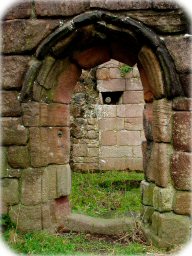Cromford Bridge Chapel - Cromford
This is a copy of an article published in The Peak Advertiser,
the Peak District's local free newspaper on 15th June 2009,
reproduced by kind permission of its author, Julie Bunting.
CROMFORD BRIDGE CHAPEL
A fodder of lead The chapel was first documented around 1504 in the will of Richard Smyth, vicar of Wirksworth, in whose parish it lay. Twenty years later it seems that the building was in a poor state of repair, since Thomas Blackwall of Wirksworth left ‘a fodder of lead’ to the chapel at Cromford, ‘as well in discharge of old reckonings, as towards the maintenance of divine service’. His intention was apparently to provide the lead specifically for re-roofing the chapel, rather than to donate its monetary value. Another bequest, this by Richard Wigley of Middleton in 1540, left two shillings ‘to chappell at Crumford’. An inventory of church goods taken just a few years later gives a picture of a very humble place of worship, possessing merely one little bell (without a clapper) and one vestment, but we have to remember that the far larger St Mary's at Wirksworth was the mother church. The inventory of St Mary's church lists silks, damask, satin and velvets, chalices of silver and gilt, and four bells. In 1650, a report by Cromwell's Parliamentary Commissioners made what is believed to be an indirect reference to the chapel at Cromford in connection with the parish church. What little is known of its subsequent use and condition includes a mid-18th-century description of the Talbot coat of arms in one window. Henry Talbot - son of Bess of Hardwick - owned the manors of Cromford and Willersley during the reign of Elizabeth 1. Restoration It was to be Sir Richard Arkwright who eventually purchased the manor of Cromford. Four years after his death in 1792, his son demolished the old chapel, which for some years had been used as two small dwellings. Parts of the walls were left standing and were in use in the 1870s as an outhouse to an adjacent cottage. By the middle of the past century, the cottage had been deserted and taken down but a rescue of the remains of the medieval bridge chapel was to be put in hand. After almost two centuries of decay, the chapel was restored by the Arkwright Society. The foundations were stabilised and the fabric of outer walls, stone steps and a weathered arched doorway were preserved. This historic little bridge chapel stands between the roadside fishing temple and the Derwent bridge, a short distance from Arkwright's Cromford Mill. Only a handful of bridge chapels survive in the whole country; one of the best preserved is also on the River Derwent, on St Mary's Bridge in Derby. © Julie Bunting |
||||
